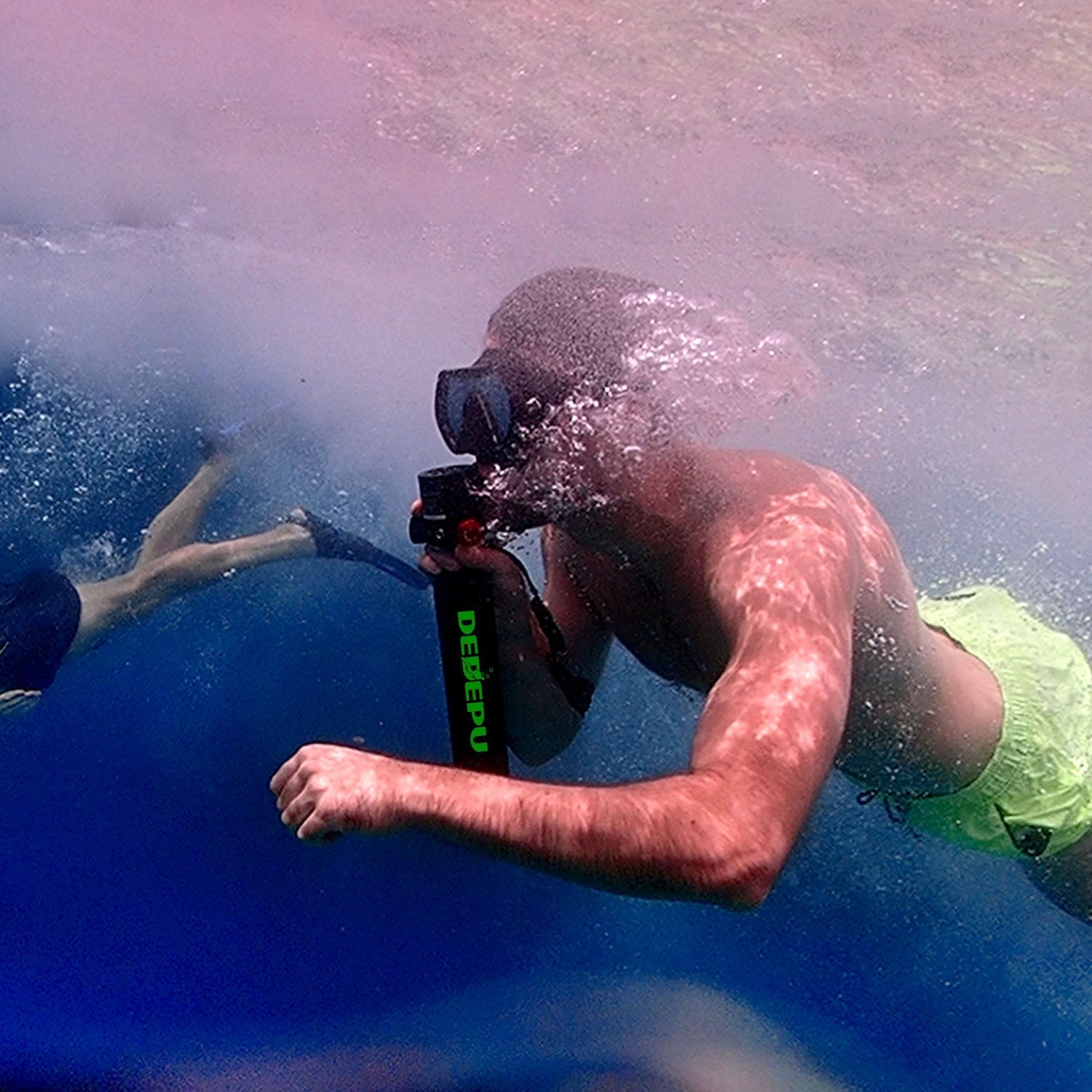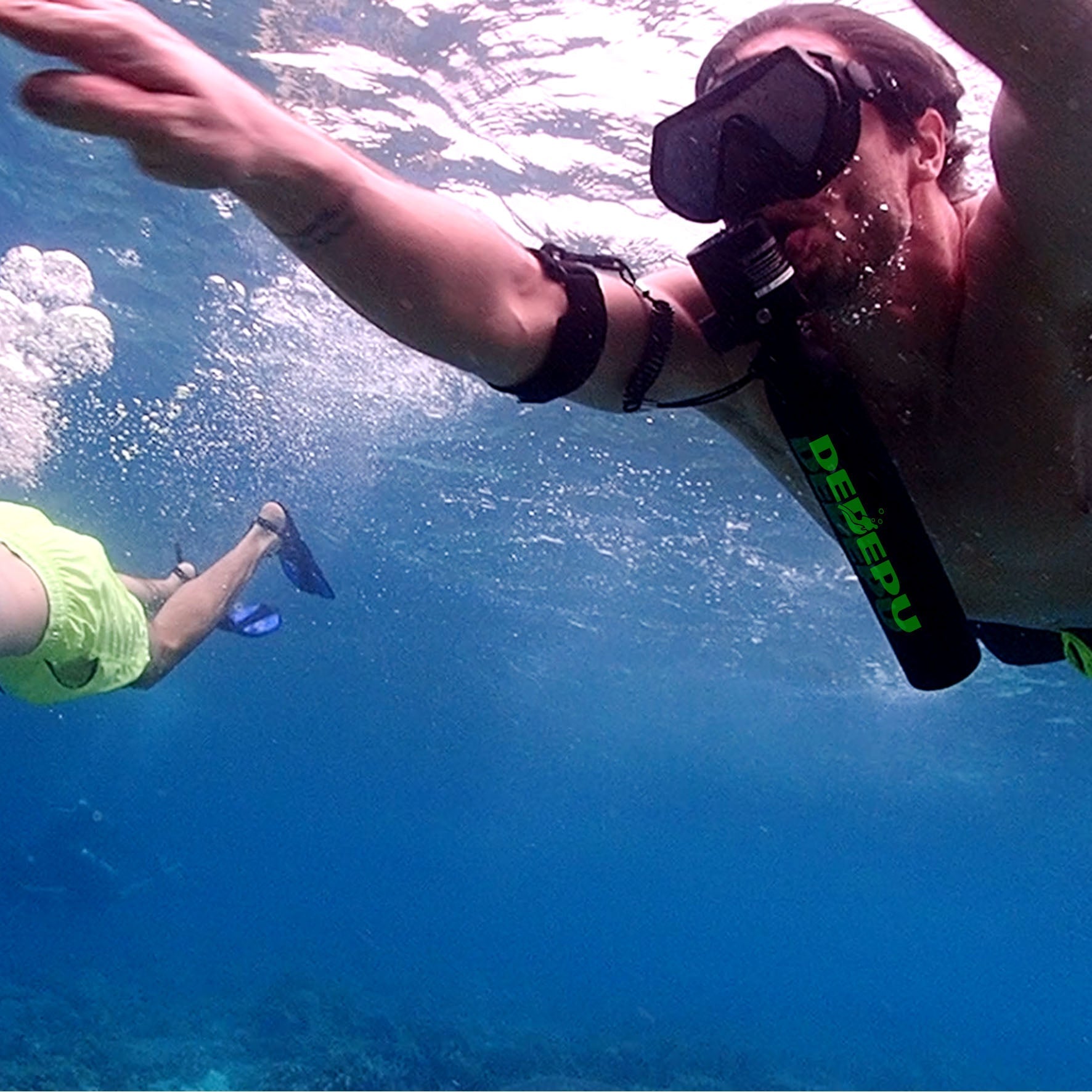Typically holding 1.5 to 6 liters of air, they provide 5 to 20 minutes of breathing time at 10 meters (33 feet), but this drops quickly at greater depths. For example, at 20 meters (66 feet), air consumption roughly doubles, cutting dive time in half. These tanks are best for shallow reef exploration, snorkeling backup, or quick underwater repairs. Always check your pressure gauge and plan dives carefully—running out of air at depth is dangerous. With proper use, mini tanks offer a lightweight, portable way to extend underwater adventures.
How Deep You Can Go Before It Gets Risky
Mini scuba tanks are great for shallow dives, but they aren’t built for deep exploration. Most manufacturers recommend staying above 18 meters (60 feet)—not just because of air supply limits, but due to physics and safety risks.
Air Consumption Doubles Every 10m (33ft) – At 10m (33ft), a 3L tank lasts ~15 minutes. At 20m (66ft), that drops to 7-8 minutes—barely enough time to ascend safely.
No Decompression Limits (NDL) Apply – Even at 12m (40ft), you only get 56 minutes before needing decompression stops. Mini tanks don’t carry enough air for that.
Pressure Risks – At 30m (100ft), the air in a mini tank is 4x denser than at the surface, making breathing harder and faster.
Safe Operating Depths by Tank Size
| Tank Size | Max Safe Depth | Estimated Dive Time |
|---|---|---|
| 1.5L | 10m (33ft) | 5-8 minutes |
| 3L | 15m (50ft) | 10-12 minutes |
| 6L | 18m (60ft) | 15-20 minutes |
Why These Limits?
Air Supply – A diver at 20m (66ft) breathes 3x faster than at the surface. A 3L tank at this depth empties in 5 minutes—too risky for most situations.
Emergency Ascent Needs – You must keep 50 bar (725 psi) reserved for a safe ascent. That’s 25% of a 200-bar tank’s capacity gone just for surfacing.
Buoyancy Changes – At 18m+ (60ft+), air expands rapidly during ascent. If you’re low on air, controlling buoyancy becomes harder.
When Depth Becomes Dangerous
Beyond 20m (66ft) – Air lasts <5 minutes in most mini tanks.
Below 30m (100ft) – Risk of nitrogen narcosis increases, and air consumption hits 4x surface rate.
Cold Water Impact – Below 10°C (50°F), regulator freezing can occur at depth, cutting off air supply.
Best Practice:
Stay above 15m (50ft) for recreational mini-tank dives.
Monitor pressure gauges every 2 minutes—air drains faster than you think.
Ascend with at least 50 bar (725 psi) remaining to avoid emergencies.

Air Supply & Dive Time
A 3L tank filled to 200 bar (2,900 psi) might give you 15 minutes at 10m (33ft), but drop to just 5 minutes at 20m (66ft). That’s because depth directly impacts air consumption.
At the surface, an average diver breathes 15-20 liters per minute (L/min).
At 10m (33ft), pressure doubles, so you consume 30-40 L/min.
At 20m (66ft), it triples to 45-60 L/min.
A 3L tank holds 600L of air (3L × 200 bar). At 20m (66ft), breathing 50 L/min, you’ll drain it in 12 minutes—but in reality, you need to reserve at least 25% for ascent, cutting usable time to 8-9 minutes.
Air Duration by Depth & Tank Size
| Tank Size | Depth | Total Air Time | Safe Dive Time* |
|---|---|---|---|
| 1.5L | 10m (33ft) | 10 min | 7 min |
| 1.5L | 20m (66ft) | 4 min | 2.5 min |
| 3L | 10m (33ft) | 15 min | 11 min |
| 3L | 20m (66ft) | 8 min | 5 min |
| 6L | 10m (33ft) | 30 min | 22 min |
| 6L | 20m (66ft) | 15 min | 10 min |
Safe Dive Time = Total Air Time minus 25% reserve for ascent.
Key Factors Affecting Air Consumption
Breathing Rate – Nervous or active divers breathe 20-30% faster, shortening dive time.
Water Temperature – Below 15°C (59°F), air consumption increases by 10-15% due to shivering.
Currents & Effort – Fighting a 1-knot current can double air usage.
Tank Pressure Loss – Steel tanks lose 5-10 bar (72-145 psi) per dive due to cooling after filling.
How to Extend Dive Time
Stay shallow – At 5m (16ft), a 3L tank lasts 25+ minutes.
Breathe slowly – Reducing intake to 12 L/min adds 2-3 minutes per dive.
Use a larger tank – A 6L tank at 10m (33ft) gives 30 minutes vs. 15 with 3L.
Avoid exertion – Glide instead of kicking hard to save air.
Rule of Thumb:
For every 10m (33ft) deeper, cut your expected dive time in half.
Always surface with 50 bar (725 psi) left—running empty at depth is dangerous.
Best Uses for Mini Tanks
Shallow Reef Exploration (5-10m/16-33ft) – With 15-25 minutes of air, you can comfortably inspect coral or marine life without bulky gear.
Snorkeling Backup – If you’re a snorkeler who occasionally dives down, a 1.5L tank adds 3-5 minutes of bottom time at 5m (16ft).
Spearfishing Safety – When diving 8-12m (26-40ft) for fish, a 3L tank ensures you have 5-7 minutes of emergency air if you overexert yourself.
Pool Training & Skill Practice – New divers can practice regulator skills for 30+ minutes in a pool with a 6L tank before needing a refill.
Underwater Photography (3-8m/10-26ft) – Photographers get 10-20 minutes to set up shots without the drag of a full scuba rig.
Top 5 Best Use Cases
| Use Case | Ideal Tank Size | Max Depth | Avg. Dive Time | Cost Savings* |
|---|---|---|---|---|
| Shallow Reef Dives | 3L | 10m (33ft) | 15 min | $50/dive |
| Snorkeling Backup | 1.5L | 5m (16ft) | 5 min | $20/tank fill |
| Spearfishing Safety | 3L | 12m (40ft) | 7 min | $100 vs. full kit |
| Pool Training | 6L | 2m (6ft) | 30 min | $80/session |
| Underwater Photography | 3L | 8m (26ft) | 12 min | $60/rental saved |
*Compared to renting full scuba gear or boat tanks.
When NOT to Use a Mini Tank
Deeper than 18m (60ft) – Air runs out too fast (under 5 minutes).
Low Visibility Conditions – If you can’t see your gauge, you risk running out of air.
Strong Currents – Fighting a 1-knot current cuts dive time by 40% or more.
Solo Diving – No redundancy if the mini tank fails.
Cost & Efficiency Breakdown
Tank Refills Cost 5-15 (vs. 10-25 for full-sized tanks).
Weighs 2-5kg (4-11 lbs) vs. 12-18kg (26-40 lbs) for standard scuba gear.
Lasts 5-30 minutes depending on depth—best for short, planned dives.
Pro Tip:If you’re using a mini tank for emergency backup, keep it strapped to your BCD—not in a bag where it’s hard to reach.

Safety Tips for Mini Tank Diving
Diving with a mini scuba tank is convenient, but safety margins are tight. A 3L tank at 20m (66ft) gives you just 5 minutes of usable air—meaning small mistakes become big problems fast.
Air runs out 3x faster at depth (30 L/min at 10m vs. 10 L/min at surface)
No redundancy – If your mini tank fails, you’re out of air immediately
Buoyancy shifts – A 3L tank weighs 2.3kg (5lbs) less when empty, affecting trim
Follow these data-driven rules to stay safe.
Essential Safety Rules
1. Reserve 25% Air for Emergencies
At 200 bar fill, start ascending at 50 bar (725 psi)
This reserves 150L of air in a 3L tank – enough for:
2-minute emergency ascent from 20m (including safety stop)
3-4 extra breaths if regulator freezes
2. Depth Determines Dive Time
| Depth | 3L Tank Duration | Safe Turnaround Point |
|---|---|---|
| 5m (16ft) | 25 minutes | 60 bar remaining |
| 10m (33ft) | 12 minutes | 75 bar remaining |
| 15m (50ft) | 7 minutes | 90 bar remaining |
| 20m (66ft) | 4 minutes | Don’t go this deep |
3. Check Pressure Every 2 Minutes
At 20m, you lose 15-20 bar per minute
Digital gauges are ±5 bar accuracy vs. analog’s ±10 bar
4. Never Dive Alone
82% of mini tank emergencies require buddy assistance
Keep your partner within 3m (10ft) at all times
5. Pre-Dive Equipment Checks
O-rings: Replace every 100 fills or 2 years
Valve threads: Inspect for cracks every 50 dives
Regulator: Service every 12 months or 150 dives
Special Situation Protocols
Currents
In 1-knot current, air consumption increases 40%
Add 50% more reserve air when diving in flow
Cold Water (<10°C/50°F)
Regulator freeze risk starts at 120 bar
Use environmentally sealed regulators below 15m
Night Diving
Attach two 300-lumen lights – one primary, one backup
Light failure probability: 7% per hour of use
Cost of Safety
| Safety Item | Price | Failure Risk Without It |
|---|---|---|
| Backup regulator | $150 | 22% higher emergency risk |
| Digital pressure gauge | $90 | 35% more pressure errors |
| Annual regulator service | $75 | 3x more freezes/failures |
Pro Tip:
Practice emergency breathing from a near-empty tank in 3m pool depth – teaches you to maximize last 20 bar of air.





Leave a comment
All comments are moderated before being published.
This site is protected by hCaptcha and the hCaptcha Privacy Policy and Terms of Service apply.